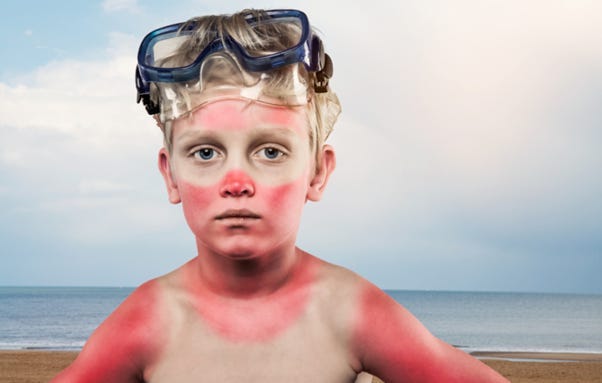Just a ‘quickie’ this time.
I mentioned in a recent post that no sun-protection is needed for skin-areas covered by clothing. That’s true for my clothing choices anyway. But a reader reminded me that some fabrics can transmit significant amounts of UV.
In fact, a few clothing manufacturers go to the trouble having their products certified to a certain UV-blocking standard, and labelling them accordingly. The label is just like an SPF, except for clothes they’re called UPFs (short for Ultraviolet Protection Factor). Why use an old acronym when we can invent another?! Of course, you’ll probably pay a bit more for UV-certified clothing because the testing costs money. But it’s mainly just a marketing ploy, because no materials used in clothing transmit significant amounts of damaging UV radiation.
This guy’s singlet, that I showed a few weeks back, was clearly very good at blocking UV. So were his goggles! Materials that transmit UVB radiation are expensive.
Therefore, in my opinion, the only fabrics you need to worry about are semi-transparent ones, usually with a very loose weave, because UV transmission through the air gaps will be the only issue. The protection factor (SPF or UPF if you prefer) will be roughly proportional the fractional area blocked by the fibres themselves. For a very loose weave, that may be only 10 percent of the cross-sectional area, leading to an effective SPF of 10. But for most fabrics the blocking will be much much greater. I’ve just checked the UV-blocking of a white handkerchief using one of these hand-held meters.
With the low UV here today (less than UVI = 2), it was hard to measure the SPF accurately, but it looked to be around 20. If you’re concerned about any fabric, you can test it yourself by looking through it at a bright light like the sky (not the direct sun please, you could damage your eyes). Your eye has a non-linear response to light intensity, so if it looks much dimmer, then it’s really very much dimmer. The UV-blocking will be similar to that for visible rays.
Next summer, when the UV is high enough for more accurate results, I must remember to measure the UV-blocking of a wider range of fabrics. I doubt if the SPF (or UPF if you prefer) of any will be lower than 20. Much less expensive than sunscreens too. And unlike sunscreens, you don’t have to worry about them wearing off.
But you’ll still need sunscreen for your face and hands.





At least I understood this!!
Thanks Richard!! As usual, amazing post!
"The protection factor (SPF or UPF if you prefer) will be roughly proportional the fractional area blocked by the fibres themselves.".
As far as I understood from this, the fabric is like a grid, where you have fibers blocking UV rays and gaps where those UV rays can go through.
If the gaps are 5% of the whole area, it means that 95% of the skin is protected, so basically this means around SPF 20/30 because it blocks 95% of the UVs. Did I understand correctly?
So what I still have to get my head around is:
That 5% of unprotected skin (gaps) gets UV rays and should theoretically be damaged by them, so you should see a sort of grid on your skin (red skin where the gaps are because it's where the UV rays go through and hit your skin), but it doesn't seem to be the case, at least I've never seen it myself in the past (it's always red where you are not protected and pale where you have clothing on). How does it work?
Same thing applies for sunscreen, if it blocks 95% of the UV rays, it means that 5% of them still go through, so you still have skin that is not protected at all and should see red spots (erythema) where those photons keep hitting, but I've never seen them.
And this leads to another question, with SPF 50 it takes 50 times longer to get erythema. Yes, I understand that it's because you get less photons, but if the few photons that go through keep hitting the same spot shouldn't you get erythema at least on that spot?
Fabio